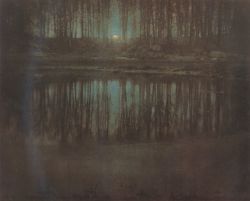Edward Steichen
Edward Steichen (March 27, 1879–March 25, 1973) was an American photographer, painter, and art gallery and museum curator, born in Bivange, Luxembourg. His family moved to the United States in 1881 and he became a naturalized citizen in 1900.
Having established himself as a fine art painter in the beginning of the 20th century, Steichen assumed the pictorialist approach in photography and proved himself a master of it. In 1905, Steichen helped create the Little Galleries of the Photo-Secession with Alfred Stieglitz. After World War I, during which he commanded the photographic division of the American Expeditionary Forces, he reverted to straight photography, gradually moving into fashion photography. Steichen's 1938 photo of actress Greta Garbo—below, featured on the Life cover of 10 January 1955—is recognized as one of the definitive portraits of Garbo.
During World War II, he served as Director of the Naval Photographic Institute. His war documentary The Fighting Lady won the 1945 Academy Award for Best Documentary. After the war, Steichen served until 1962 as the Director of Photography at New York's Museum of Modern Art.
Among other accomplishments, Steichen is appreciated for creating The Family of Man in 1955, a vast exhibition at the Museum of Modern Art consisting of over 500 photos that depicted life, love and death in 68 countries. Steichen's brother-in-law, Carl Sandburg, wrote the introduction for the exhibition catalog (ISBN 0-8109-6169-5). As had been Steichen's wish, the exhibition was donated to the Grand Duchy of Luxembourg. It is now permanently housed in the Luxembourg town of Clervaux. [1]
Recently a show of early color photographies by Edward Steichen has also been held at Mudam Luxembourg.
The Pond-Moonlight
In February of 2006, a copy of Steichen's early pictorialist photograph, The Pond-Moonlight (1904), sold for the highest price ever paid for a photograph at auction, U.S. $2.9 million.
Steichen took photograph in Mamaroneck, New York near the home of his friend, art critic Charles Caffin. The photo features a wooded area and pond, with moonlight appearing between the trees and reflecting on the pond. While the print appears to be a color photograph, the first true color photographic process, the autochrome process, was not available until 1907. Steichen created the impression of color by manually applying layers of light-sensitive gums to the paper. In 1904, only a few photographers were using this experimental approach. Only three known versions of the Pond-Moonlight are still in existence and, as a result of the hand-layering of the gums, each is unique. In addition to the auctioned print, the other two versions are held in museum collections. The extraordinary sale price of the print is, in part, attributable to its one-of-a-kind character and to its rarity.[2]
ReferencesISBN links support NWE through referral fees
Further reading
- Edward Steichen (1955). The family of man: the greatest photographic exhibition of all time. New York: Published for the Museum of Modern Art by Maco Pub. Co.
- Anne Cohen DePietro and Mary Anne Goley (2003). Eduard Steichen: Four Paintings in Context. New York: Hollis Taggart Galleries.
- Joel Smith (1999). Edward Steichen: The Early Years. Princeton, NJ: Princeton University Press.
External links
- Edward J. Steichen Online
- Edward Steichen Photographs
- bloom! Experiments in color photography by Edward Steichen at Mudam
Credits
New World Encyclopedia writers and editors rewrote and completed the Wikipedia article in accordance with New World Encyclopedia standards. This article abides by terms of the Creative Commons CC-by-sa 3.0 License (CC-by-sa), which may be used and disseminated with proper attribution. Credit is due under the terms of this license that can reference both the New World Encyclopedia contributors and the selfless volunteer contributors of the Wikimedia Foundation. To cite this article click here for a list of acceptable citing formats.The history of earlier contributions by wikipedians is accessible to researchers here:
The history of this article since it was imported to New World Encyclopedia:
Note: Some restrictions may apply to use of individual images which are separately licensed.

